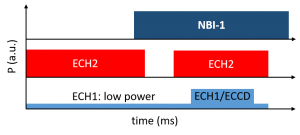TJ-II: Searching for AEs suppression scenarios using off-axis ECCD
Experimental campaign
2019 Autumn
Proposal title
Searching for AEs suppression scenarios using off-axis ECCD
Name and affiliation of proponent
Á. Cappa, C. Hidalgo, E. Ascasíbar (Laboratorio Nacional de Fusión)
Details of contact person at LNF
Á. Cappa
Background
The goal of the proposal is to find ECRH launching configurations for which the amplitude of NBI-driven Alfvén Eigenmodes (AEs) is mitigated. Besides the interest that such scenarios have for the fast particles topic, studies of coupling between NBI-driven AEs and low frequency zonal flows may also benefit from them. Many scenarios making use of different "control" parameters have already been tested in past experimental sessions, showing always strong changes in AEs activity. Plasma density variations and changes of the rotational transform profile due to the many contributions to the total plasma current (NBCD, ECCD, Bootstrap current) are the parameters with the higher impact. However, although inducing modifications in the general spectrum of the excited modes, none of the investigated scenarios show a clear possibility to suppress AEs without inducing large changes in plasma parameters, being the most promising the one employing ECCD. In this particular case we intend to investigate the effect of off-axis ECCD at different plasma radius.
Experimental plan

Until now, only ECCD on-axis has been investigated. We will now try to modify the rotational transform profile by inducing ECCD off-axis with different levels of power at different plasma radius. The heating power set-up shown in figure 1 will allow us to investigate the effect of ECCD using different combinations of ECH1 beam power and ECCD efficiency. With this set-up, launching ECH2 power with , only a small amount of ECCD current will be induced by the ECH1 beam during the ECRH phase while the larger amount of ECCD will be induced during the NBI phase by increasing the ECH1 beam power. For stability purposes ECH1 must be working at low power from the begginning of the shot until higher power is requested.
Description of required resources
Required resources:
- Number of plasma discharges or days of operation: One day - 20 useful shots
- Essential diagnostic systems: Besides the common shot to shot diagnostics (ECE, Thomson, Interferometry, Radiation), all systems providing edge plasma profiles are needed. Moreover, HIBP, Doppler Reflectometer, Mirnov coils (both helicoidal and poloidal arrays) and CNPA meaurements are mandatory. MSE would also be desirable to measure changes induced by ECCD.
- Type of plasmas (heating configuration): ECRH + NBI-1 hydrogen plasmas following the heating scheme shown in Figure 1.
Preferred dates and degree of flexibility
Preferred dates: No preferred dates at the time of the proposal submission
References